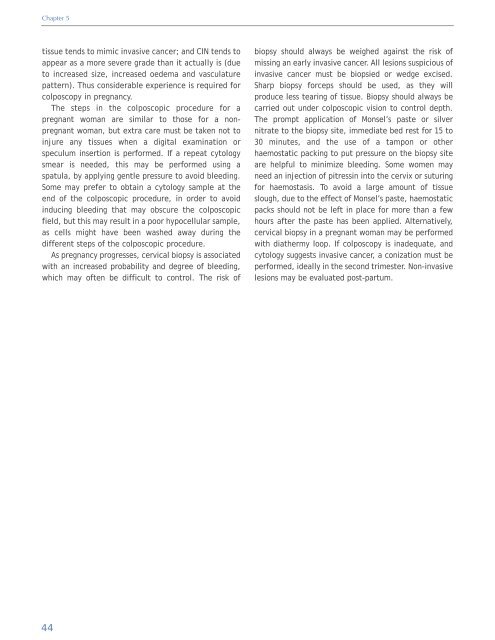Colposcopy and Treatment of Cervical Intraepithelial Neoplasia - RHO
Colposcopy and Treatment of Cervical Intraepithelial Neoplasia - RHO
Colposcopy and Treatment of Cervical Intraepithelial Neoplasia - RHO
Create successful ePaper yourself
Turn your PDF publications into a flip-book with our unique Google optimized e-Paper software.
Chapter 5<br />
tissue tends to mimic invasive cancer; <strong>and</strong> CIN tends to<br />
appear as a more severe grade than it actually is (due<br />
to increased size, increased oedema <strong>and</strong> vasculature<br />
pattern). Thus considerable experience is required for<br />
colposcopy in pregnancy.<br />
The steps in the colposcopic procedure for a<br />
pregnant woman are similar to those for a nonpregnant<br />
woman, but extra care must be taken not to<br />
injure any tissues when a digital examination or<br />
speculum insertion is performed. If a repeat cytology<br />
smear is needed, this may be performed using a<br />
spatula, by applying gentle pressure to avoid bleeding.<br />
Some may prefer to obtain a cytology sample at the<br />
end <strong>of</strong> the colposcopic procedure, in order to avoid<br />
inducing bleeding that may obscure the colposcopic<br />
field, but this may result in a poor hypocellular sample,<br />
as cells might have been washed away during the<br />
different steps <strong>of</strong> the colposcopic procedure.<br />
As pregnancy progresses, cervical biopsy is associated<br />
with an increased probability <strong>and</strong> degree <strong>of</strong> bleeding,<br />
which may <strong>of</strong>ten be difficult to control. The risk <strong>of</strong><br />
biopsy should always be weighed against the risk <strong>of</strong><br />
missing an early invasive cancer. All lesions suspicious <strong>of</strong><br />
invasive cancer must be biopsied or wedge excised.<br />
Sharp biopsy forceps should be used, as they will<br />
produce less tearing <strong>of</strong> tissue. Biopsy should always be<br />
carried out under colposcopic vision to control depth.<br />
The prompt application <strong>of</strong> Monsel’s paste or silver<br />
nitrate to the biopsy site, immediate bed rest for 15 to<br />
30 minutes, <strong>and</strong> the use <strong>of</strong> a tampon or other<br />
haemostatic packing to put pressure on the biopsy site<br />
are helpful to minimize bleeding. Some women may<br />
need an injection <strong>of</strong> pitressin into the cervix or suturing<br />
for haemostasis. To avoid a large amount <strong>of</strong> tissue<br />
slough, due to the effect <strong>of</strong> Monsel’s paste, haemostatic<br />
packs should not be left in place for more than a few<br />
hours after the paste has been applied. Alternatively,<br />
cervical biopsy in a pregnant woman may be performed<br />
with diathermy loop. If colposcopy is inadequate, <strong>and</strong><br />
cytology suggests invasive cancer, a conization must be<br />
performed, ideally in the second trimester. Non-invasive<br />
lesions may be evaluated post-partum.<br />
44
















